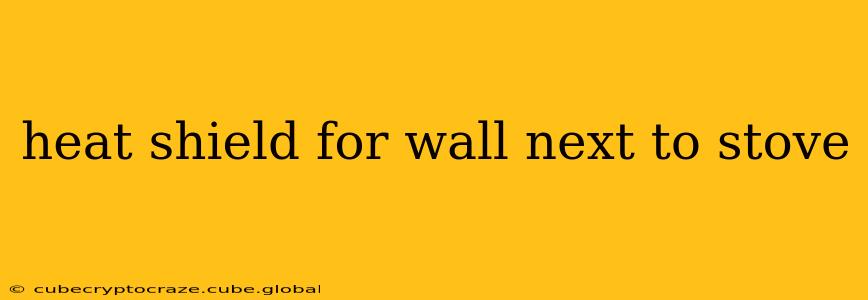Cooking is a fundamental part of life, but the heat generated by stoves can pose a significant risk to your home's safety. A wall adjacent to your stove is particularly vulnerable to damage from excessive heat, leading to discoloration, warping, and even fire. Installing a heat shield is a crucial preventative measure to protect your property and ensure your family's safety. This comprehensive guide explores the various types of heat shields, their installation, and factors to consider when choosing the right one for your kitchen.
What is a Heat Shield for a Stove?
A heat shield for a stove is a protective barrier designed to absorb and deflect heat radiating from the cooking appliance. This prevents direct heat transfer to the adjacent wall, safeguarding it from damage and reducing the risk of fire. They come in a variety of materials and designs to suit different needs and aesthetics.
Types of Heat Shields
Several types of heat shields offer varying levels of protection and aesthetic appeal:
1. Metal Heat Shields: These are commonly made from stainless steel, aluminum, or galvanized steel. They offer excellent heat resistance and are durable, making them a popular choice. Stainless steel is particularly favored for its sleek appearance and easy cleaning.
2. Tempered Glass Heat Shields: Tempered glass heat shields provide a modern, transparent alternative to metal shields. They allow you to see the wall behind them, maintaining the visual appeal of your kitchen while offering significant heat protection. However, they might be more fragile than metal options.
3. Ceramic Tile or Brick Heat Shields: These offer a more traditional and visually appealing option. They can be easily installed as a backsplash, providing both heat protection and a decorative element. However, they might require more extensive installation.
4. Heat-Resistant Paint: While not a direct shield, heat-resistant paint can provide a layer of protection against minor heat exposure. However, it’s less effective than a dedicated shield for significant heat sources.
How to Install a Heat Shield for Stove
The installation process varies depending on the type of heat shield chosen. Metal shields often require mounting directly to the wall using screws or adhesive, while tile or brick backsplashes require more extensive installation involving mortar and grouting. Always consult the manufacturer's instructions for detailed guidance. Consider these key steps:
- Measure the area: Accurately measure the wall section requiring protection to ensure the correct size shield is purchased.
- Prepare the surface: Clean the wall thoroughly to ensure proper adhesion.
- Mark the mounting points: Mark the locations for screws or adhesive if necessary.
- Mount the shield: Carefully attach the shield following the manufacturer’s instructions.
- Inspect for stability: Ensure the shield is securely mounted and stable.
Note: If unsure about the installation, consider consulting a professional contractor.
What Size Heat Shield Do I Need?
The size of the heat shield you need depends on the size of your stove and the distance between the stove and the wall. Generally, it's recommended to have a shield that extends at least several inches beyond the stove's widest point on either side and extends to at least the same height as the stovetop. It is better to err on the side of caution and select a larger shield to ensure adequate protection.
How Far Should a Heat Shield Extend Beyond the Stove?
The heat shield should extend beyond the stove's perimeter to capture the majority of radiated heat. A minimum of 4-6 inches on each side and above the stovetop is generally recommended, but more is better, especially with high-heat cooking appliances.
Is a Heat Shield Necessary?
While not always mandatory depending on local building codes, a heat shield is highly recommended for safety and to prevent costly wall damage, especially with gas stoves or ranges with high-heat outputs. The long-term benefits outweigh the initial cost.
Can I Use Alternative Materials as a Heat Shield?
While some materials like thick plywood might seem like an option, they are not adequate substitutes for a proper heat shield and can be a fire hazard. Only use materials specifically designed as heat shields for this purpose.
This guide provides comprehensive information about heat shields for walls next to stoves. Remember that safety should always be your priority, so if in doubt, consult a qualified professional.
